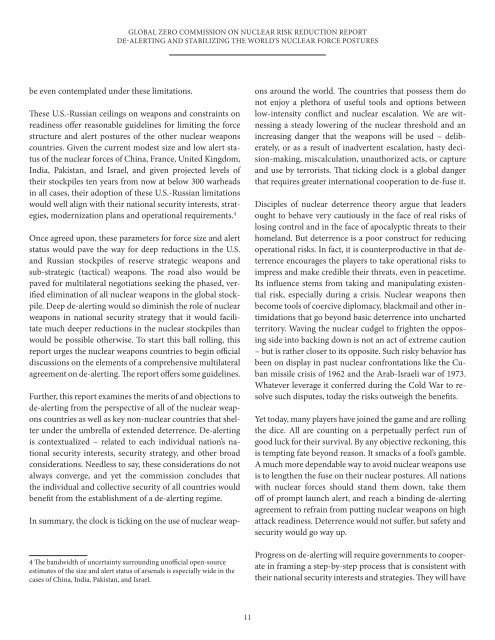global_zero_commission_on_nuclear_risk_reduction_report
global_zero_commission_on_nuclear_risk_reduction_report
global_zero_commission_on_nuclear_risk_reduction_report
You also want an ePaper? Increase the reach of your titles
YUMPU automatically turns print PDFs into web optimized ePapers that Google loves.
GLOBAL ZERO COMMISSION ON NUCLEAR RISK REDUCTION REPORTDE-ALERTING AND STABILIZING THE WORLD’S NUCLEAR FORCE POSTURESbe even c<strong>on</strong>templated under these limitati<strong>on</strong>s.These U.S.-Russian ceilings <strong>on</strong> weap<strong>on</strong>s and c<strong>on</strong>straints <strong>on</strong>readiness offer reas<strong>on</strong>able guidelines for limiting the forcestructure and alert postures of the other <strong>nuclear</strong> weap<strong>on</strong>scountries. Given the current modest size and low alert statusof the <strong>nuclear</strong> forces of China, France, United Kingdom,India, Pakistan, and Israel, and given projected levels oftheir stockpiles ten years from now at below 300 warheadsin all cases, their adopti<strong>on</strong> of these U.S.-Russian limitati<strong>on</strong>swould well align with their nati<strong>on</strong>al security interests, strategies,modernizati<strong>on</strong> plans and operati<strong>on</strong>al requirements. 4Once agreed up<strong>on</strong>, these parameters for force size and alertstatus would pave the way for deep reducti<strong>on</strong>s in the U.S.and Russian stockpiles of reserve strategic weap<strong>on</strong>s andsub-strategic (tactical) weap<strong>on</strong>s. The road also would bepaved for multilateral negotiati<strong>on</strong>s seeking the phased, verifiedeliminati<strong>on</strong> of all <strong>nuclear</strong> weap<strong>on</strong>s in the <str<strong>on</strong>g>global</str<strong>on</strong>g> stockpile.Deep de-alerting would so diminish the role of <strong>nuclear</strong>weap<strong>on</strong>s in nati<strong>on</strong>al security strategy that it would facilitatemuch deeper reducti<strong>on</strong>s in the <strong>nuclear</strong> stockpiles thanwould be possible otherwise. To start this ball rolling, this<strong>report</strong> urges the <strong>nuclear</strong> weap<strong>on</strong>s countries to begin officialdiscussi<strong>on</strong>s <strong>on</strong> the elements of a comprehensive multilateralagreement <strong>on</strong> de-alerting. The <strong>report</strong> offers some guidelines.Further, this <strong>report</strong> examines the merits of and objecti<strong>on</strong>s tode-alerting from the perspective of all of the <strong>nuclear</strong> weap<strong>on</strong>scountries as well as key n<strong>on</strong>-<strong>nuclear</strong> countries that shelterunder the umbrella of extended deterrence. De-alertingis c<strong>on</strong>textualized – related to each individual nati<strong>on</strong>’s nati<strong>on</strong>alsecurity interests, security strategy, and other broadc<strong>on</strong>siderati<strong>on</strong>s. Needless to say, these c<strong>on</strong>siderati<strong>on</strong>s do notalways c<strong>on</strong>verge, and yet the <str<strong>on</strong>g>commissi<strong>on</strong></str<strong>on</strong>g> c<strong>on</strong>cludes thatthe individual and collective security of all countries wouldbenefit from the establishment of a de-alerting regime.In summary, the clock is ticking <strong>on</strong> the use of <strong>nuclear</strong> weap-4 The bandwidth of uncertainty surrounding unofficial open-sourceestimates of the size and alert status of arsenals is especially wide in thecases of China, India, Pakistan, and Israel.<strong>on</strong>s around the world. The countries that possess them d<strong>on</strong>ot enjoy a plethora of useful tools and opti<strong>on</strong>s betweenlow-intensity c<strong>on</strong>flict and <strong>nuclear</strong> escalati<strong>on</strong>. We are witnessinga steady lowering of the <strong>nuclear</strong> threshold and anincreasing danger that the weap<strong>on</strong>s will be used – deliberately,or as a result of inadvertent escalati<strong>on</strong>, hasty decisi<strong>on</strong>-making,miscalculati<strong>on</strong>, unauthorized acts, or captureand use by terrorists. That ticking clock is a <str<strong>on</strong>g>global</str<strong>on</strong>g> dangerthat requires greater internati<strong>on</strong>al cooperati<strong>on</strong> to de-fuse it.Disciples of <strong>nuclear</strong> deterrence theory argue that leadersought to behave very cautiously in the face of real <strong>risk</strong>s oflosing c<strong>on</strong>trol and in the face of apocalyptic threats to theirhomeland. But deterrence is a poor c<strong>on</strong>struct for reducingoperati<strong>on</strong>al <strong>risk</strong>s. In fact, it is counterproductive in that deterrenceencourages the players to take operati<strong>on</strong>al <strong>risk</strong>s toimpress and make credible their threats, even in peacetime.Its influence stems from taking and manipulating existential<strong>risk</strong>, especially during a crisis. Nuclear weap<strong>on</strong>s thenbecome tools of coercive diplomacy, blackmail and other intimidati<strong>on</strong>sthat go bey<strong>on</strong>d basic deterrence into unchartedterritory. Waving the <strong>nuclear</strong> cudgel to frighten the opposingside into backing down is not an act of extreme cauti<strong>on</strong>– but is rather closer to its opposite. Such <strong>risk</strong>y behavior hasbeen <strong>on</strong> display in past <strong>nuclear</strong> c<strong>on</strong>fr<strong>on</strong>tati<strong>on</strong>s like the Cubanmissile crisis of 1962 and the Arab-Israeli war of 1973.Whatever leverage it c<strong>on</strong>ferred during the Cold War to resolvesuch disputes, today the <strong>risk</strong>s outweigh the benefits.Yet today, many players have joined the game and are rollingthe dice. All are counting <strong>on</strong> a perpetually perfect run ofgood luck for their survival. By any objective reck<strong>on</strong>ing, thisis tempting fate bey<strong>on</strong>d reas<strong>on</strong>. It smacks of a fool’s gamble.A much more dependable way to avoid <strong>nuclear</strong> weap<strong>on</strong>s useis to lengthen the fuse <strong>on</strong> their <strong>nuclear</strong> postures. All nati<strong>on</strong>swith <strong>nuclear</strong> forces should stand them down, take themoff of prompt launch alert, and reach a binding de-alertingagreement to refrain from putting <strong>nuclear</strong> weap<strong>on</strong>s <strong>on</strong> highattack readiness. Deterrence would not suffer, but safety andsecurity would go way up.Progress <strong>on</strong> de-alerting will require governments to cooperatein framing a step-by-step process that is c<strong>on</strong>sistent withtheir nati<strong>on</strong>al security interests and strategies. They will have11


